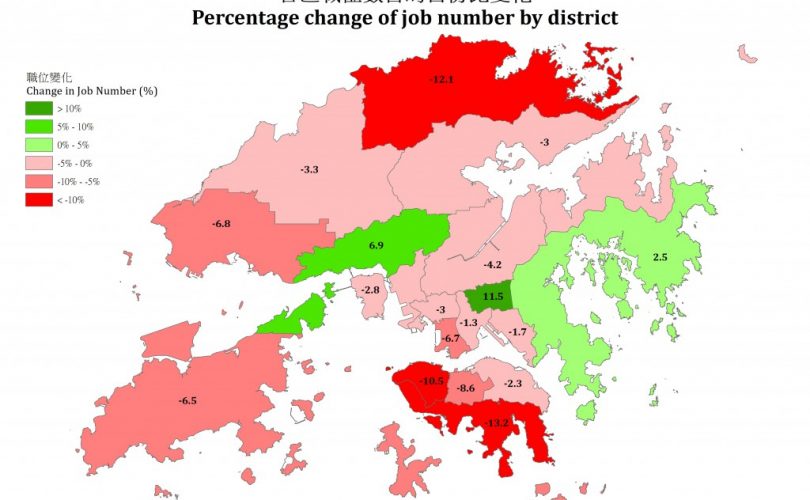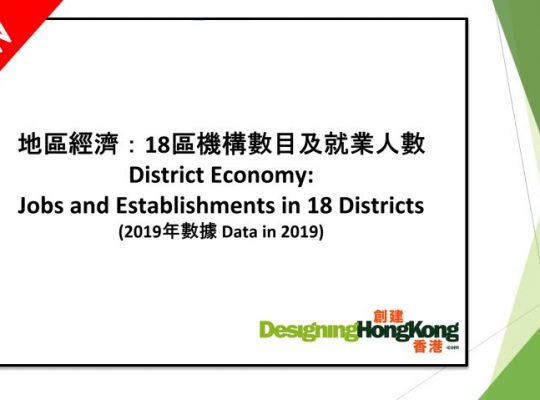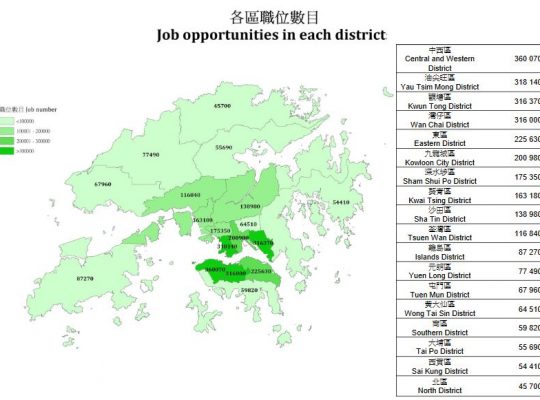Red colour represents a shrinking job market while green colour represents a growing job market. The data reflects the change in job number in each district between September 2019 and September 2020.
District level job losses up to 13%
The impact of COVID on our economy is accelerating. While Government reported an overall unemployment rate of 6.6%, a study of district data by ‘Designing Hong Kong’ shows local impacts vary. Job losses in the Southern District is 13% for the year ending September 2020. Some industries at district level show job losses of over 50%.
Compared with the latest available data, we have lost more than 125 000 jobs compared with the data of the third quarter one year ago. This accounts for 4.4% of the job market. Import/export trade and wholesale, and accommodation and food services suffered the most. More than 10% of the jobs or nearly 100 000 jobs were lost in these industries in one year.
Traditional commercial centres such as the Central and Western District, Wan Chai District and Yau Tsim Mong District suffered greatly from the economic recession. In these districts, the import/export and wholesale; accommodation and food services; and retail suffered and lead to 10.5%, 8.6% and 6.9% loses in jobs in these districts respectively.
The economies of the Southern District and North District suffered most. Their job markets lost 13.2% and 12.1% of the jobs. This means that one out of every eight jobs were lost during the pandemic. This is worrisome as nearly half (Southern District: 48.3%; North District 53.8%) of the jobs in some districts are taken up by local residents.
Meanwhile, three districts recorded an increase in jobs. Wong Tai Sin and Tsuen Wan showed an 11.5% and 6.9% increase in jobs. It appears to be primarily industries which benefit from changes in consumer behaviour in times of Covid, including food and courier services representing online shopping and centralised food preparation.
Analyses of the performance of the different industries in each district give out hints of possible longer term shifts in the economy. In Kwun Tong, import/export and wholesale are the largest job sectors and these lost 8 555 jobs last year. On the other hand, administrative and supporting services industries have gained more than 7 000 jobs, further strengthening their position as the second largest industry in Kwun Tong. Similarly, in Yuen Long, real estate and education industries lost some 2 600 jobs. These were compensated by a rise in jobs in the accommodation and food services, and manufacturing industries.
To identify the challenges facing the Hong Kong economy in times of Covid we need to look at the performance of industries at district levels. It is not simply about the banking industry, or the Greater Bay Area. We need to uncover opportunities for Hong Kong at district level. We need to embrace this ‘re-set’ to discover new opportunities and restructure our economy. We need to develop a more resilient and more vibrant economy in every district.
Click here for detailed breakdown of the performance of the job market in each district this last year.
Learn more about District Economy:
Fixing the economy, one district at at time
Understanding the economies of Hong Kong’s districts
Source:
Census and Statistics Department (2020). Number of establishments and persons engaged (other than those in the Civil Service) analysed by industry section, District Council district and sex.
經濟衰退—地區損失逾13%職位
疫情對香港經濟的影響逐漸浮現,政府報告的最新失業率升至6.6%。創建香港早前研究了各地區的就業環境,發現疫情對各區的影響有所不同。截至2020年9月,南區的職位數目下跌了13%,為全港之冠。在地區層面,部份行業的職位數目更減少了一半。
紅色代表萎縮的就業市場,而綠色代表增長的市場。數據反映了2019年9月至2020年9月之間每個地區的職位數目變化。
根據政府提供最新的數據,與一年前的第三季度比較,我們損失了超過125 000個職位,佔了就業市場的4.4%。當中進出口貿易及批發和住宿及膳食服務兩個行業受最大打撃。一年間兩個行業各自損失了超過10%的職位,合共令就業市場減少了接近十萬個職位。
疫情對傳統的商業中心例如中西區、灣仔區和油尖旺區造成嚴重的打擊。受到進出口貿易及批發、住宿及膳食服務及零售業的萎縮,這三區分別流失了10.5%、8.6%及6.9%的職位。
全港18區中,南區和北區的就業市場受到最大的打擊。兩區的就業市場分別萎縮了13.2%及12.1%,這代表在疫情期間損失了八份一的職位。更令人擔憂的是,這兩個地區的職位中,有大約一半的職位(南區48.3%;北區53.8%)都聘請了當區居民(更多有關本區就業的數據),因此職位的減少對當區的經濟名居民帶來極大的影響。
雖然整體的就業市場持續萎縮,但有三區的職位數目卻有所提升。當中黃大仙區11.5%的增幅最為突出,而荃灣亦有6.9%的增長。仔細查看各行業的變動,可以發展兩區的住宿及膳食服務和運輸、倉庫、郵政及速遞服務皆有顯著的升幅,這可能與疫情間消費模式改變有關。
細看各個地區的職位變化亦可以找出部份地區未來的發展方向。以觀塘為例,進出口貿易及批發是該區的最大行業,但在過去一年卻失去了8 555個職位。但另一方面,行政及支援服務比去年提供多超過7 000個職位,進一步鞏固它們在觀塘第二大產業的地位。同樣地,元朗的地產及教育合共在去年失去了大約2 600個職位,但住宿及膳食服務及製造業的擴張卻彌補了這些損失。
在這個充滿挑戰的經濟環境下尋找出路,我們不應只將目光放在金融業或大灣區發展,更需要了解我們社區的經濟表現,去發掘各區獨有的機遇。我們應該藉此機會去「重新設置」我們的城市,去調整我們的經濟架構和發掘更多的可能性,從而令各個地區都發展出一套更多元化及具韌性的經濟。
按此去了解各區去年的就業市場表現。
了解更多有關地區經濟:
資料來源:
政府統計處(2020)。按行業主類、區議會分區及性別劃分的機構單位數目及就業人數(公務員除外)




